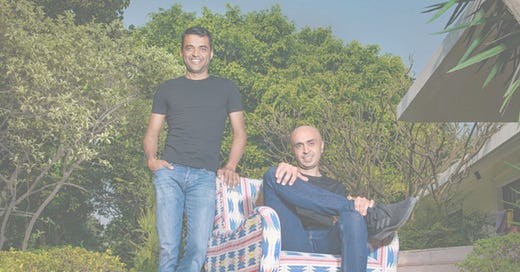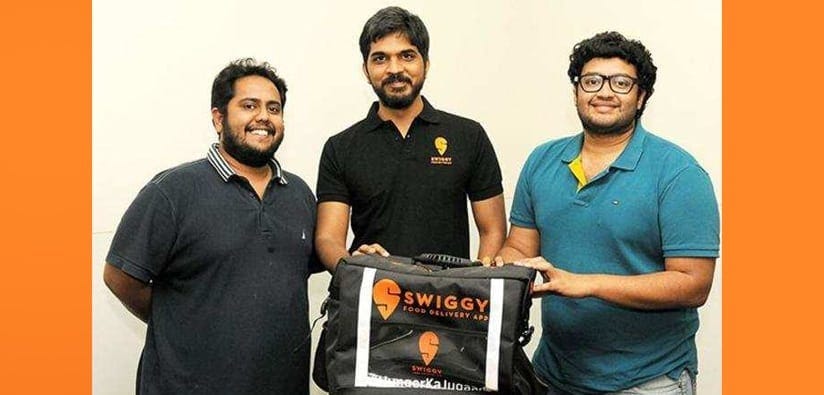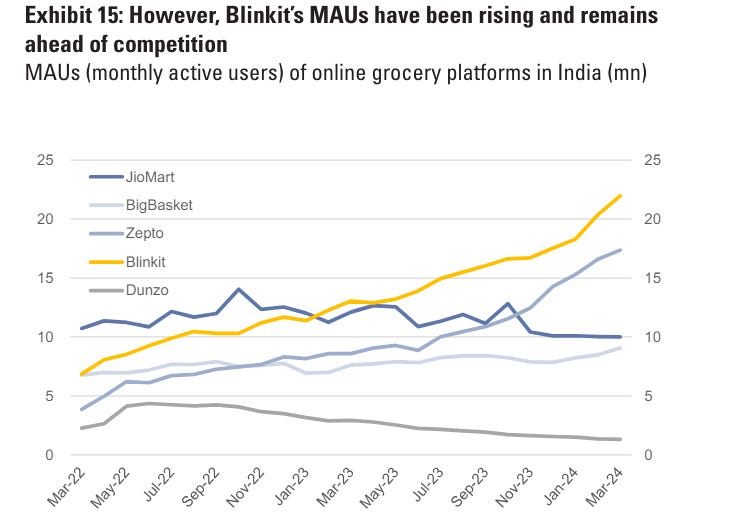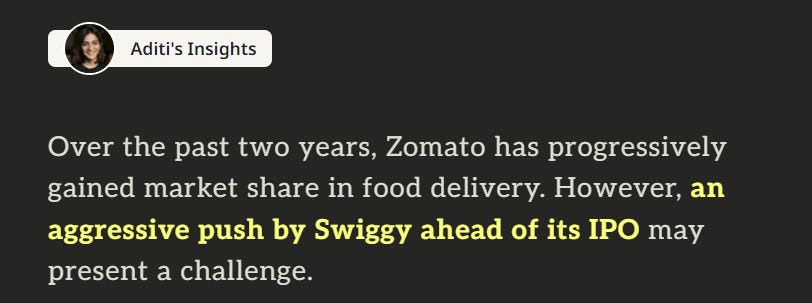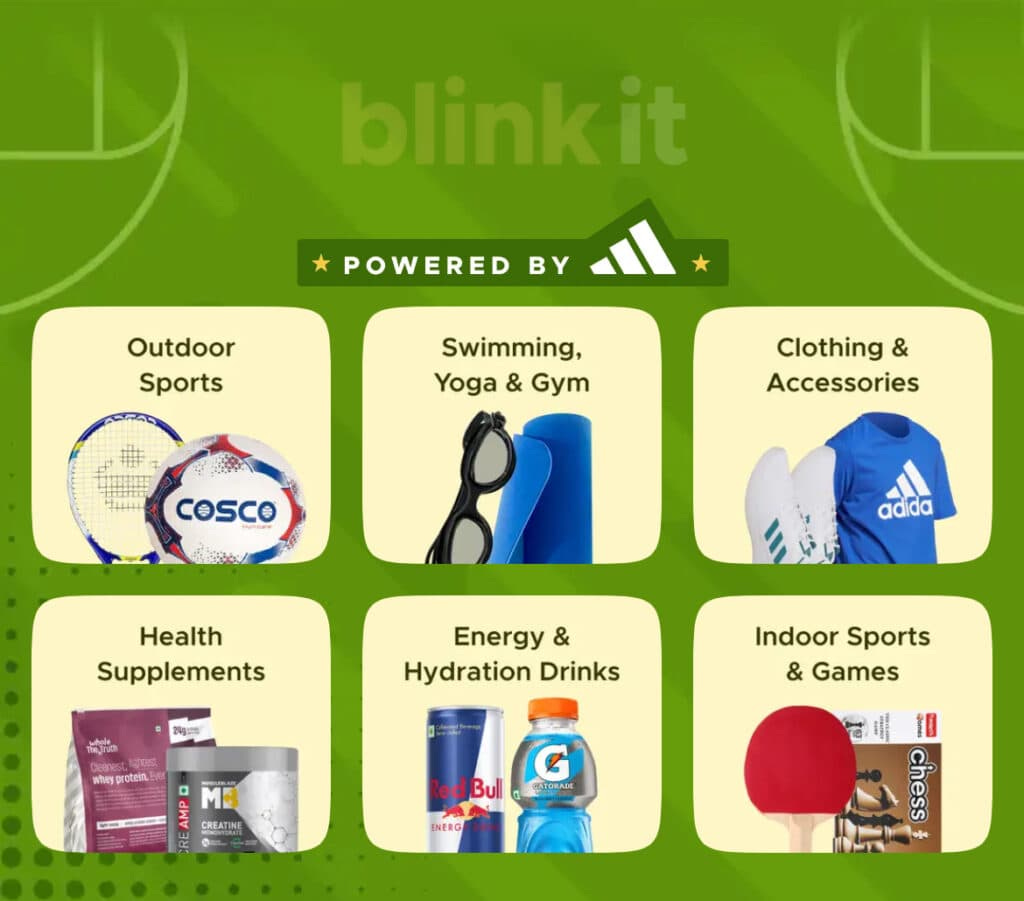Survival of the Quickest
Can Blinkit conquer the Quick Commerce battleground in this ferocious phase?
I previously wrote about how Quick Commerce (QC) in India has proven its mettle over the last two years. In case you haven’t read it, I would highly recommend reading it for better context here: ‘Fast, Faster, Delivered!’.
As I write, competition is heating up with many players in this space raising huge sums:
Zepto is in talks to raise $650 Mn in a funding round led by Nexus Venture Partners and multiple reputed names including Lightspeed Venture Partners, DST Global, and Avra
Similarly, Invesco and Baron Capital-backed Swiggy is about to launch its IPO of $1.2 billion, of which $450 Mn is expected to be a fresh issue that goes to the company
Then we have Walmart-backed Flipkart, which is entering this space in a big way. Google recently infused $350 Mn into it in May 2024
Reliance Retail (part of India’s highest valued group, Reliance Industries) is re-entering the space after their Dunzo investment didn’t work well
Tata-owned BigBasket has started to expand significantly, including in my Tier-2 town of Ludhiana, where previously only Blinkit was present
Firstly, the above activity is a testimony to the fact that quick commerce is the future of Indian retail. From groceries to clothes to electronics and more, delivered in under a few minutes, QC is now easily eating away the share of other channels, including online/e-commerce channels.
Mentioning it upfront, I have been long on Zomato for many months now, and today’s blog focuses on whether Zomato’s subsidiary, Blinkit, will be able to survive such tough competition. Early signs show the company is capable, well-prepared, and has enough past experience of surviving the toughest situations they have faced, always emerging stronger. We will discuss our reasoning one by one today. I hope you enjoy reading our blog. If I add value to your hypothesis, please consider supporting me and my team to perform better research - click here. Now, let’s get started!
What differentiates you from competitors?
In the startup world, one must remain humble at all times as disruption is the foundation upon which an organization is built. If you don’t innovate constantly, somebody else will and can overtake you in just a few months. Given the lucrativeness of the opportunity, big money is bound to join the fight. Remember, India's retail industry is projected to expand to $4.5 trillion by the end of this decade. Even if QC captures a 2-4% share of that pie from 0% at the start of the decade, a significant shift is underway that will impact existing retail players and channels.
Recently, in an interview, when asked about competitors raising big funds, Deepinder (Zomato’s founder & CEO) acknowledged that the real competition between them and other players is not about fleet size, stores, discounts, or any tactics, as these can be financed or replicated easily in a few months. The real differentiating factor, or the moat, comes when your employees think differently and there is a culture within the organization to constantly innovate to stay ahead. This is what Zomato has been striving to inculcate.
The constant need to innovate is what makes investing in companies like Zomato a ‘high-risk, high-reward’ proposition. It’s about disrupting existing practices or being disrupted by newer, better ones. Zomato's attempt to develop this moat is partially reflected in three different examples:
Every new employee at Zomato receives Deepinder’s written piece - ‘Culture at Zomato: How to Rewire Your Brain for Greatness’, as part of their welcome kit. While it's uncertain how many new employees actually read the book, it sends a strong message that work culture is a top priority at Zomato.
The company has appointed a CFO (Chief Fitness Office) dedicated to employee well-being, promoting a culture of sports and exercise. Deepinder and Albinder (Blinkit’s founder & CEO) themselves strive to be benchmarks in fitness, which motivates many employees to focus on their health, fostering a sense of belonging (I confirmed this with a few current employees - many employees at Zomato/Blinkit are now fitness freaks)
Zomato has also been very generous with ESOPs (Employee Stock Ownership Plans), particularly before the IPO. They recently launched another ESOP pool worth Rs 3,000 Crores for key senior employees, boosting morale and fostering a sense of ownership within the firm
So the attempt is there, and only time will tell how successful they become in nurturing that moat. I shall continue bringing you the latest insights here in my blogs time to time. Now, let's move on to how Blinkit’s parent, Zomato, has fought and thrived in similar situations in the past.
When Swiggy was on the Rise….
Back in December 2018, Swiggy raised over $1 Bn to provide itself with ammunition against Zomato, Ola-owned Foodpanda and Uber Eats. Swiggy's existing investors like Naspers along with new strong names like Tencent & Hillhouse Capital, together closed the biggest funding deal in India's food tech at the time.
On the other hand, Zomato had almost nothing in its bank account to fight back and then sold its UAE business a few months later in March 2019 to Delivery Hero for $172 Mn in order to survive the storm caused by Swiggy's mega fundraise.
Small players couldn't compete, and in May 2019, Ola decided to shut down Foodpanda. A few months later, even Uber Eats was up for sale in the latter part of 2019, and Zomato acquired it in January 2020 in an all-equity deal, giving 10% of its equity shares to the parent company Uber to acquire 100% of Uber Eats. In fact even big pockets players like Amazon who entered the Indian food delivery market in Nov 2020, and launched the business in select pin codes of Bengaluru only to shut it down later after 2 years and terming it as an 'experiment'.
𝐑𝐞𝐬𝐮𝐥𝐭𝐬? - Zomato today continues to enjoy over 60% market share in the food delivery market in India. Zomato has demonstrated the ability to navigate through tough, near-death situations, which instills greater confidence that, come what may, the company's leaders—along with guiding figures like Sanjeev Bikhchandani—have the capability to steer the company successfully in the future as well.
Who is winning the Rich Indians?
In India, income and wealth distribution is skewed, with a small group of high middle class and rich individuals driving the majority of consumption in the economy. Goldman Sachs expects this so-called ‘affluent’ group of Indians to touch 10 crore individuals by 2027. These individuals will be the key drivers of consumption growth, especially in discretionary spending. This group will drive demand for flights, hotels, cars, and of course, iPhones.
Bringing this into today’s context for quick commerce, let's compare the app last 3 months downloads trend of Blinkit, Swiggy, and Zepto on iPhones and Android phones, as reported by SensorTower:
In the last three months of app downloads for the three major names in quick commerce (QC) in India, it is interesting to note that Blinkit has consistently led in download rankings, even surpassing Swiggy (integrated both food delivery and QC) by slight margin in daily app downloads on iPhones. On Android phones, however, Blinkit currently ranks third, below Swiggy and Zepto. Hence Blinkit has been a consistent hit for iPhone holders (which are relatively convenience preferers) but not so for Android holders (which are relatively value seekers). It’s important to note that this data fluctuates frequently and is influenced by multiple variables. For instance, a player pushing the pedal on app advertising can cause a sudden spike in downloads.
If we step back from analyzing just three months of download data and look at how things have evolved over the two years from the onset of QC until the end of the Financial Year 2024 in March, Blinkit has consistently led with the highest number of monthly active users. Meanwhile, Zepto has been catching up quickly. (Source: Goldman Sachs)
Who does the Delivery Free? Blinkit Doesn’t!
The reason I showed you the latest three-month app download data and monthly active users data is to highlight a significant change: Blinkit has started charging a delivery fee on almost all of its orders, regardless of the order size. According to their shareholder's letter for Q4 FY24, they mention:
Almost 100% of our orders in March 2024 had a non-zero delivery fee with an average delivery fee per order of INR 20. - Zomato Shareholder note, May 2024
This is another sign that Blinkit has successfully tapped into the premium segment of customers who prioritize convenience and service over price. Not only are they able to charge for the service they provide, but they also continue to maintain their growth momentum. This is evident in their increasing number of monthly active users in March 2024 and beyond, growing at a faster pace.
This is happening at a time when Zepto launched its ‘Premium Pass’ for providing free delivery providing unlimited free deliveries to its pass holders at mere Rs 19/month subscription fee and Swiggy on the other hand is trying to push sales higher with its attractively priced ‘Swiggy One Premium’ which was earlier priced at Rs 200/month for most users but are now being offered to many at Rs 49/month. This can help Swiggy gain back market share, and show good QoQ growth before coming for IPO that is expected to happen towards end of 2024/start of 2025. Here is an insert from The Arc:
In an environment of increasing competition, how Blinkit reacts becomes critical. Their response is clear till now: they won’t engage in unsustainable short-term actions but will continue to focus on quality -
We believe that a business built on the back of great service quality is much tougher (more defensible) than just offering lower prices (unsustainable subsidies). We plan to stick to making our service even more reliable and loved for our customers. And just like today, we will strive to maintain an edge over competition for the quality and innovation that we stand for. - Zomato Shareholder note, May 2024
It is obvious that at some point in the future, Blinkit will need to launch a membership program like Zepto and Swiggy to gain further customer loyalty. However, that is still some distance away, as the company is currently focused on improving supply chains for greater efficiencies, expanding dark stores, and increasing SKUs. They are attempting to build a business model that helps them get the products available at the lowest price to consumers as Blinkit is able to pass on those efficiencies and benefits of scale over time along with help of another Zomato’s subsidiary - Hyperpure, which streamlines the entire perishable ordering process by being a one-stop-shop
More SKUs, more profitability?
While the primary selling point for all existing players continues to be ‘free delivery,’ Blinkit has consistently taken a different approach by launching new categories. They recently introduced various products under the sports category to tap into the growing craze for outdoor activities, which usually peaks in summer. These new categories help Blinkit acquire new customers and assist in margin expansion, as these are high-margin products. Though, competitors have followed suit and have also widened their SKUs.
Quick Commerce continues to be an every evolving space and we shall continue to track it closely for you. In case you liked reading today’s blog, do share it with your friends who would enjoy reading it too. If my emails end up in the ‘promotions’ tab, please move them to inbox so you don’t miss out.
You can find me LinkedIn here.
Wondering how you can support us?
If you find our content valuable & are willing to support, show some love here⬇️
Disclaimers-
I am not a SEBI registered advisor; personal investment/interest in the shares exists for the company mentioned above; this isn’t investment advice but my personal thought process; DYOR (do your own research) is recommended; Investing & trading are subject to market risk; the decision maker is responsible for any outcome.

